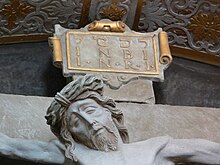Quod scripsi, scripsi (Latin for "What I have written, I have written") is a Latin phrase. It was most famously used by Pontius Pilate in the Bible in response to the Jewish priests who objected to his writing "King of the Jews" on the sign (titulus) that was hung above Jesus at his Crucifixion. It is mostly found in the Latin Vulgate Bible.[1] It is equivalent to the Latin expression Dixi (Latin for "I have said"), meaning that the speaker has spoken and there is no more to be said.


History edit
The phrase appears in the Bible in John 19:20–22. When Jesus was sent to be crucified, Pilate wrote the sign to be hung above Jesus on the cross. He wrote "Jesus the Nazarene, King of the Jews" in Hebrew (or, more correctly, Aramaic.[2]) Latin and Ancient Greek. The Jewish priests voiced their objections of this to Pilate, stating that Jesus had only claimed the title and they did not recognise Him as such. They said to Pilate, "Do not write King of the Jews, but that he said: 'I am the King of the Jews'."[3] Pilate responded to them sternly with "Quod scripsi, scripsi" (Greek: Ὃ γέγραφα γέγραφα, Ho gegrapha gegrapha). This was interpreted by Jerome as an allusion to the headings of Psalm 56 and Psalm 57, which in the Vulgate seem to refer to an inscription that is not to be changed.[3][4]
The scene where Pilate says "Quod scripsi, scripsi" was not covered in art or discussion as a popular subject. Aside of the Bury St. Edmunds Cross there was little discussion on it in the pre-Reformation Christian Church. It was suggested that this may have been because it is only mentioned in detail by John the Evangelist and because it was mentioned in the apocryphal Acts of Pilate.[4]
Other uses edit
In 1306, when Henry II of Jerusalem signed a patent to give the Kingdom of Cyprus to the governorship of Amalric, Lord of Tyre, the marshal of the temple accompanying Amalric reportedly said "Quod scripsi, scripsi" with disdain to Henry when he signed the patent.[5]
On being released from imprisonment in 1418, Antipope John XXIII came, broken down and destitute, to Florence, and was given an asylum there by Giovanni di Bicci de' Medici, who, when the deposed Pope died in the following year, erected to his memory the tomb which is to be seen in the Florence Baptistery. When the inscription was put up (after Giovanni's death), Pope Martin V objected to the words "Quandam Papa" (former Pope) and wrote to the Signoria demanding that they should be erased. The reply was a refusal, written by Cosimo de' Medici, and couched in the words of Pontius Pilate, saying, "Quod scripsi, scripsi."[6]
The philosopher Immanuel Kant used a play on "Quod scripsi, scripsi" in response to critics of his Metaphysics of Morals, using "Quod scripsi, scribentes" (What I have written, I am writing).[7]
References edit
- ^ "The Cloisters Cross". Metropolitan Museum of Art – The Cloisters. Retrieved 2014-03-18.
- ^ The HarperCollins Study Bible, new revised standard version, ISBN 0-06-065580-1, p. 2051
- ^ a b Brown, Raymond Edward (1988). The Gospel and Epistles of John. p. 93. ISBN 0-8146-1283-0.
- ^ a b Longland, Sabrina. "Pilate answered 'What I have written, I have written'" (PDF). Metropolitan Museum of Art. Retrieved 2014-03-18.
- ^ Hill, George (2010). A History of Cyprus. Vol. 2 (reprint ed.). Cambridge University Press. p. 230. ISBN 978-1108020633.
- ^ Young, Colonel George Frederick, C.B. (1930). The Medici. New York: Modern Library. p. 33, note 22. OCLC 246920716.
{{cite book}}: CS1 maint: multiple names: authors list (link) - ^ Baumgarten, Alexander (2013) [1766 Metaphysica]. Metaphysics: A Critical Translation with Kant's Elucidations, Selected Notes, and Related Materials. Translated by Courtney D. Fugate; John Hymers. Bloomsbury. p. 76. ISBN 978-1-4411-9674-3.